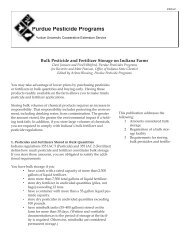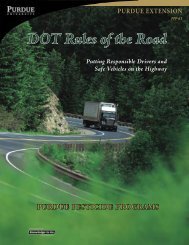Pesticides and Risk Communication PPP-52 - Purdue Pesticide ...
Pesticides and Risk Communication PPP-52 - Purdue Pesticide ...
Pesticides and Risk Communication PPP-52 - Purdue Pesticide ...
Create successful ePaper yourself
Turn your PDF publications into a flip-book with our unique Google optimized e-Paper software.
In addition, the authority to establish pesticide tolerances for food was<br />
transferred from the Food <strong>and</strong> Drug Administration to EPA, placing the<br />
agency in full control of the pesticide registration process.<br />
Public Policy Sets the Stage<br />
for Rules Governing <strong><strong>Pesticide</strong>s</strong><br />
It is interesting that the development of policy to correct one potential<br />
problem—unreasonable risk to human health <strong>and</strong> the environment—in<br />
fact fueled additional pesticide concerns. This cause <strong>and</strong> effect scenario<br />
shaped key historical decisions from which pesticide rules <strong>and</strong> regulations<br />
have emerged.<br />
• The furor surrounding pesticides marked them for extensive<br />
governmental scrutiny. FIFRA was amended by regulation to<br />
protect human health <strong>and</strong> the environment; <strong>and</strong> with EPA responsible<br />
for the regulation of pesticides from registration to final<br />
disposal, critics had but one agency to target.<br />
• The party in power appoints EPA’s upper management personnel;<br />
<strong>and</strong> their decisions in turn reflect political influence. All decisions<br />
are public.<br />
• EPA must decide how to implement public policies that meet the<br />
imprecise definition of safe. As defined by Congress, safe means<br />
that when the product is used according to its label it will not<br />
cause “unreasonable adverse effects on human health or the<br />
environment”; <strong>and</strong> that there is “reasonable certainty that no harm<br />
will result from aggregate exposure to the pesticide chemical<br />
residue, including all anticipated dietary exposures <strong>and</strong> all other<br />
exposures for which there is reliable information.”<br />
What on the surface seems to be a clear <strong>and</strong> reasonable definition<br />
of safe is actually quite murky. What is reasonable certainty? What<br />
effects are unreasonable? One person’s definition of safe can be<br />
another’s definition of dangerous. For example, a homeowner who uses<br />
pesticides in her garden may view them harmless—that is, safe—<br />
except to targeted pests; but the neighbor who watched his pet die after<br />
ingesting a pesticide might consider them dangerous. Regulatory<br />
interpretation lies with each generation of policymakers who comm<strong>and</strong><br />
their own historical, political, <strong>and</strong> scientific perspectives. What was<br />
deemed unacceptable in the past may be viewed as acceptable or even<br />
desirable, now; <strong>and</strong> what is acceptable, today, may not be, tomorrow.<br />
• EPA is responsible for both environmental research <strong>and</strong> environmental<br />
regulation, but it is often faulted for failing to fulfill these<br />
obligations.<br />
• EPA requires pesticide manufacturers to perform numerous tests<br />
<strong>and</strong> to submit data in support of their product for registration. The<br />
10




